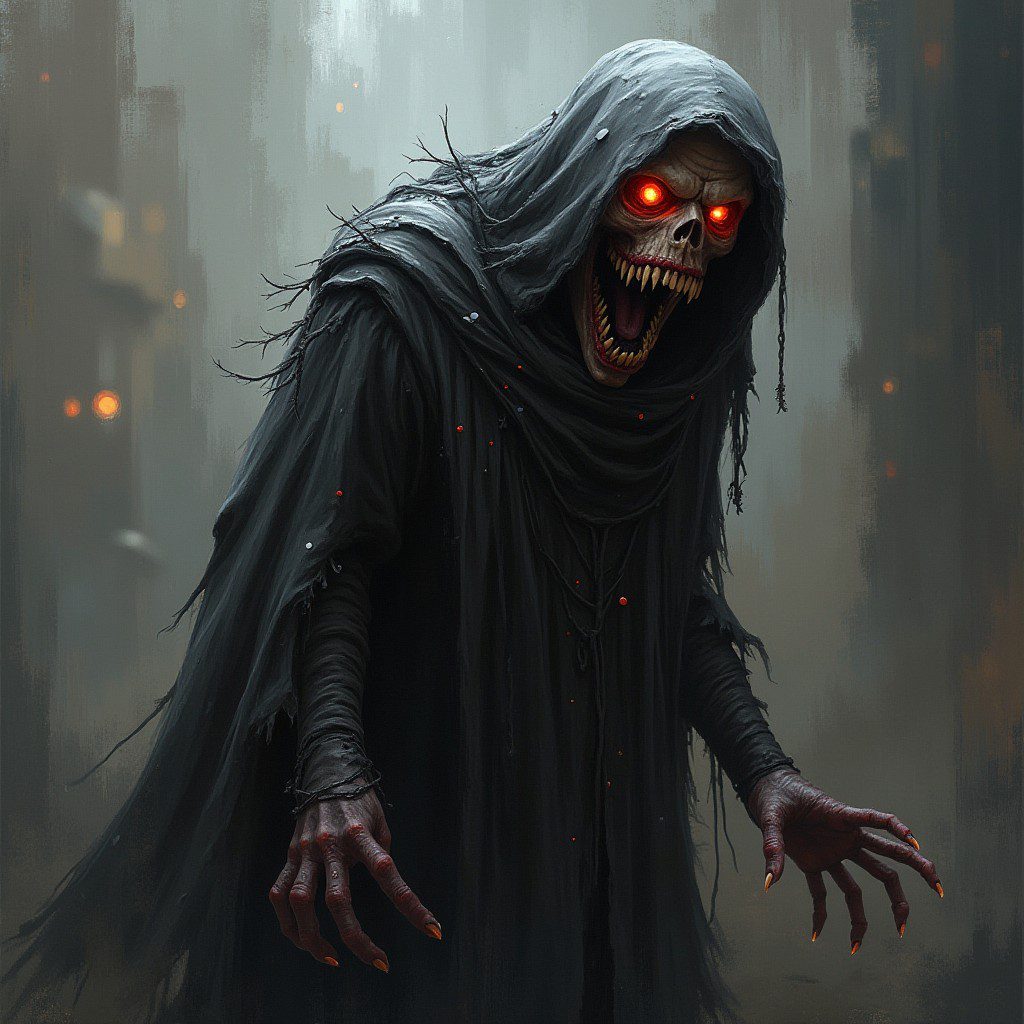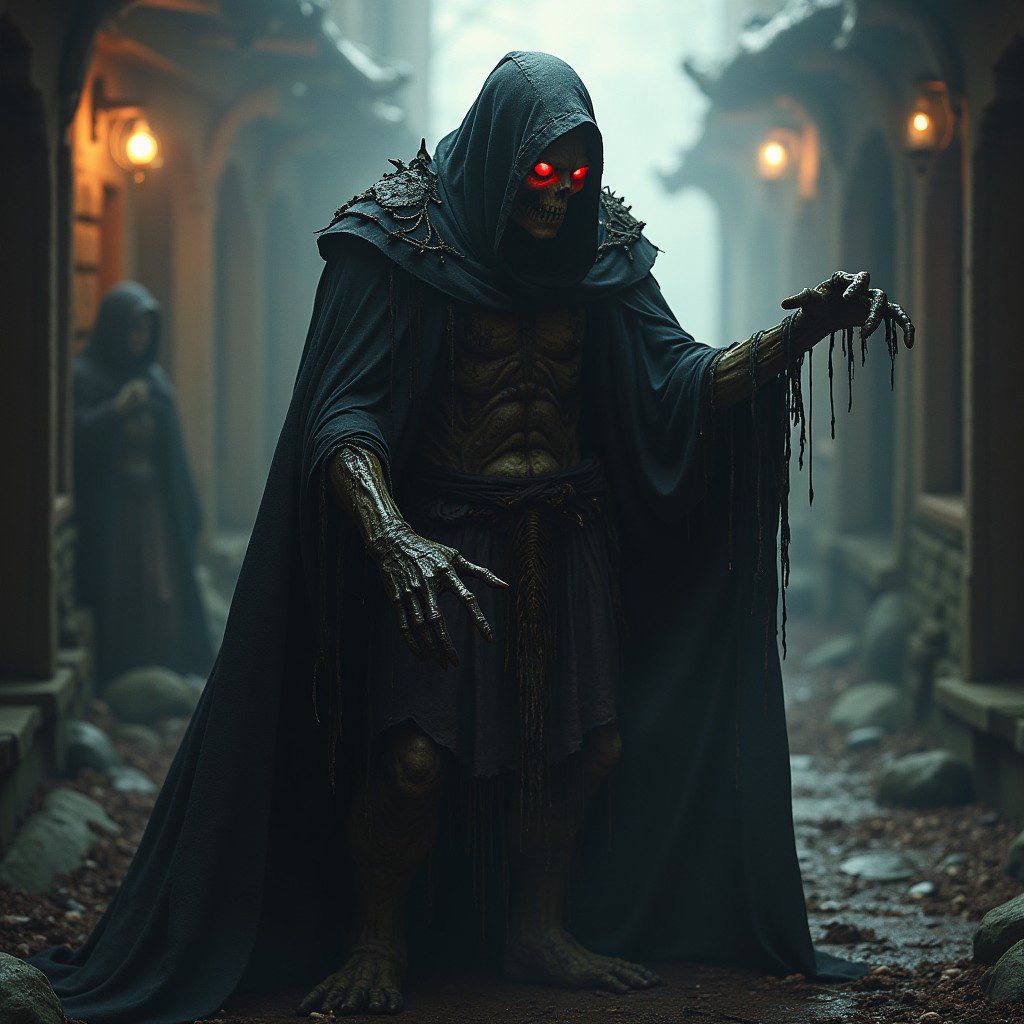Ghouls: The Flesh-Eating Undead of Myth and Fantasy

A Ghoul is a terrifying creature from Middle Eastern folklore and later European mythology, often depicted as an undead or demonic being that feeds on the flesh of the dead or living. Ghouls have become a staple in horror literature, films, and games, symbolizing death, decay, and the horror of cannibalism. Unlike other forms of the undead, ghouls are known for their insatiable hunger for human flesh, particularly from graveyards or battlefields where bodies are abundant
A Ghoul is a terrifying creature from Middle Eastern folklore and later European mythology, often depicted as an undead or demonic being that feeds on the flesh of the dead or living. Ghouls have become a staple in horror literature, films, and games, symbolizing death, decay, and the horror of cannibalism. Unlike other forms of the undead, ghouls are known for their insatiable hunger for human flesh, particularly from graveyards or battlefields where bodies are abundant.
While originally from Arabic folklore, the concept of the ghoul has evolved in Western media, becoming one of the most recognizable monsters in modern horror and fantasy settings. The ghoul embodies both the fear of death and the grotesque horror of desecrating the dead.
Origins and Mythological Background
The word “ghoul” comes from the Arabic term ghūl, which refers to a malevolent spirit or demon that haunts burial grounds and feasts on human corpses. In pre-Islamic Arabian mythology, ghouls were believed to inhabit deserts and graveyards, luring travelers to their doom by shape-shifting or mimicking the appearance of humans or animals. Ghouls were said to feast on the flesh of the dead, but they could also attack the living, making them dangerous predators.
Arabic Folklore
In Arabian folklore, ghouls were often associated with the djinn, a class of supernatural beings capable of possessing humans or animals. Ghouls, however, were considered particularly malevolent due to their association with death and decay. The ghoul would typically dwell in abandoned places, graveyards, or ruins, where it would wait for unsuspecting victims or feast on the bodies of the dead. It was believed that ghouls could shape-shift, often appearing as beautiful women or animals to lure people into their lairs.
One of the earliest references to ghouls in Arabic literature appears in the “One Thousand and One Nights” (also known as Arabian Nights), where they are portrayed as dangerous, flesh-eating demons. Over time, the ghoul became a common figure in Middle Eastern folklore, representing the dangers of venturing into the unknown and the violation of sacred burial grounds.
European Adaptation

The concept of the ghoul was introduced to Western literature in the 18th and 19th centuries, where it was adapted from its Arabian origins into the Gothic horror tradition. In European mythology, ghouls became associated more specifically with grave robbing, cannibalism, and vampirism. The creature’s association with death and decay made it a fitting monster for the emerging horror genre.
The ghoul gained popularity in European literature with writers like Horace Walpole and Lord Byron, but it was H.P. Lovecraft who solidified the ghoul’s place in modern horror. In Lovecraft’s works, ghouls are monstrous, subterranean creatures that live in catacombs and tunnels, feeding on corpses and sometimes interacting with humans in dark, twisted ways.
Characteristics of Ghouls
Ghouls are typically depicted as hideous, corpse-like creatures with a ravenous hunger for human flesh. Over the centuries, their characteristics have evolved, but certain traits remain consistent in most depictions.
1. Undead Nature
Ghouls are usually portrayed as undead beings, similar to zombies or vampires. They are often depicted with decayed or rotting flesh, skeletal frames, and glowing eyes, giving them an appearance of death and corruption. Unlike zombies, ghouls retain a certain level of intelligence and cunning, making them more dangerous than mindless undead creatures.
2. Cannibalistic Hunger
The defining trait of the ghoul is its insatiable hunger for human flesh, particularly that of the recently deceased. Ghouls are often depicted haunting graveyards or catacombs, digging up graves to feast on the corpses inside. However, in some versions of the myth, ghouls are just as willing to attack and eat the living, often luring their victims into traps or ambushes.
3. Shape-Shifting
In some folklore, ghouls have the ability to shape-shift, often appearing as normal humans, animals, or even the recently deceased. This ability allows them to lure unsuspecting travelers or gravediggers into their lairs, only revealing their true monstrous form when it is too late. This characteristic, more prominent in Middle Eastern versions of the myth, emphasizes the ghoul’s deceptive and cunning nature.
4. Association with Graveyards and Ruins
Ghouls are most commonly associated with desolate or forsaken places, particularly graveyards, tombs, battlefields, or abandoned ruins. These places offer ghouls a steady supply of corpses to feed on, as well as seclusion from human society. In some stories, ghouls inhabit underground tunnels or crypts, emerging at night to hunt for food.
Ghouls in Modern Fantasy and Horror
In modern literature, films, and video games, ghouls are often portrayed as horrifying, flesh-eating monsters. Their connection to death and their insatiable hunger for human flesh make them iconic figures in horror settings. They also appear in fantasy works, where they serve as formidable enemies for heroes to defeat.
1. H.P. Lovecraft
H.P. Lovecraft’s stories frequently feature ghouls as part of his Cthulhu Mythos. In Lovecraft’s “The Dream-Quest of Unknown Kadath”, ghouls are portrayed as subterranean, corpse-eating creatures that inhabit the Dreamlands, a fantastical and surreal alternate reality. Lovecraft’s ghouls, while still horrific, are more than mindless monsters; they are capable of communication and even form societies underground, adding a complex layer to their depiction.
In his story “Pickman’s Model,” Lovecraft describes ghouls as humanlike creatures that have become more monstrous and degenerate through their consumption of human flesh. These ghouls are grotesque, but they maintain some degree of intellect, making them terrifying yet fascinating figures in the story.
2. Dungeons & Dragons
In Dungeons & Dragons (D&D), ghouls are a common type of undead monster. They are often described as once-human creatures that were transformed into ghouls through dark magic or curses, becoming flesh-eating undead. D&D ghouls retain their intelligence, making them cunning and dangerous foes for adventurers. They are known for their ability to paralyze their victims with a touch, allowing them to feast on their prey without resistance.
A more powerful variant of the ghoul, the ghast, also appears in D&D, with greater strength and abilities, and it often serves as a leader of ghoul packs.
3. Video Games
Ghouls are common enemies in many video games, particularly in horror and fantasy genres. Their appearance as rotting, flesh-eating monsters makes them perfect antagonists in these settings.
- The Elder Scrolls: In The Elder Scrolls series, ghouls are often referred to as draugr, ancient undead warriors who guard tombs and crypts. While not called ghouls directly, their cannibalistic tendencies and undead nature make them a variation on the classic ghoul archetype.
- Fallout: In the Fallout series, ghouls are humans who have been transformed into decaying, radioactive creatures due to prolonged radiation exposure. Some ghouls in the series are mindless and feral, attacking anything they see, while others retain their intelligence and personality, but are still marked by their grotesque, rotting appearance.
- Dark Souls: In Dark Souls, ghouls appear as twisted, reanimated corpses that hunt for flesh. They are relentless enemies, often attacking in groups and using their brute strength to overwhelm the player.
4. Films and Literature
Ghouls frequently appear in horror films, often serving as graveyard-dwelling monsters or the reanimated dead. Their association with cannibalism and their grotesque appearance make them a staple in zombie and undead-themed horror.
In literature, ghouls often appear as minor antagonists in Gothic horror novels and short stories, usually haunting crypts or battlefields. While they may not be as popular as vampires or zombies, ghouls are often used to evoke the horror of death and decay, particularly in stories where desecration of the dead plays a central theme.
Strengths and Weaknesses of Ghouls
Strengths:
- Undead Nature: Ghouls are often immune to many afflictions that affect living creatures, such as disease, poison, or the need for rest. This makes them tireless hunters, relentless in their pursuit of food.
- Cannibalistic Strength: Ghouls are often portrayed as incredibly strong, capable of overpowering humans with ease. Their hunger for flesh drives them to attack with savage ferocity.
- Paralysis (in some depictions): In settings like Dungeons & Dragons, ghouls have the ability to paralyze their victims with a touch or bite, rendering their prey helpless and making them easy to devour.
Weaknesses:
- Sunlight (in some depictions): Like many undead creatures, ghouls are sometimes vulnerable to sunlight or holy light, which can weaken or destroy them. This is especially common in folklore where ghouls are nocturnal beings.
- Lack of Intelligence: While ghouls are often intelligent enough to set traps or lure prey, they are generally portrayed as simple-minded and driven purely by hunger. This makes them susceptible to tricks and traps.
- Holy Symbols and Magic: Ghouls, as undead creatures, are vulnerable to holy symbols, spells, or weapons imbued with divine power. In many stories, they can be banished or destroyed by clerics or paladins using sacred magic.
The Legacy of Ghouls in Horror and Fantasy
Ghouls remain one of the most horrifying and enduring creatures in mythology and fantasy. Their association with death, decay, and cannibalism taps into primal fears of the unknown and the desecration of the dead. Whether portrayed as mindless flesh-eaters or cunning, grave-robbing monsters, ghouls continue to serve as powerful symbols of the grotesque and the macabre in modern horror and fantasy settings.
Their appearance in films, games, and literature ensures that ghouls will continue to haunt graveyards, catacombs, and the darkest corners of the imagination for generations to come.
